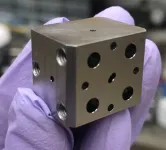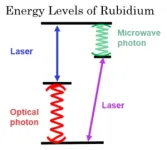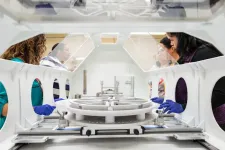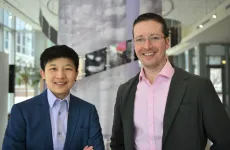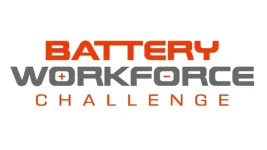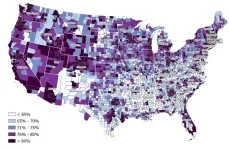(Press-News.org) Researchers have discovered a way to “translate” quantum information between different kinds of quantum technologies, with significant implications for quantum computing, communication, and networking.
The research, published in the journal Nature on Wednesday, was funded by the Army Research Office (ARO), the Air Force Office of Scientific Research (AFOSR), and the NSF Quantum Leap Challenge Institute for Hybrid Quantum Architectures and Networks (HQAN), which is led by the University of Illinois Urbana-Champaign. It represents a new way to convert quantum information from the format used by quantum computers to the format needed for quantum communication.
Photons—particles of light—are essential for quantum information technologies, but different technologies use them at different frequencies. For example, some of the most common quantum computing technology is based on superconducting qubits, such as those used by tech giants Google and IBM; these qubits store quantum information in photons that move at microwave frequencies.
But if you want to build a quantum network, or connect quantum computers, you can’t send around microwave photons because their grip on their quantum information is too weak to survive the trip.
“A lot of the technologies that we use for classical communication—cell phones, Wi-Fi, GPS and things like that—all use microwave frequencies of light,” said Aishwarya Kumar, a postdoc at the James Franck Institute at University of Chicago and lead author on the paper. “But you can’t do that for quantum communication because the quantum information you need is in a single photon. And at microwave frequencies, that information will get buried in thermal noise.”
The solution is to transfer the quantum information to a higher-frequency photon, called an optical photon, which is much more resilient against ambient noise. But the information can’t be transferred directly from photon to photon; instead, we need intermediary matter. Some experiments design solid state devices for this purpose, but Kumar’s experiment aimed for something more fundamental: atoms.
The electrons in atoms are only ever allowed to have certain specific amounts of energy, called energy levels. If an electron is sitting at a lower energy level, it can be excited to a higher energy level by hitting it with a photon whose energy exactly matches the difference between the higher and lower level. Similarly, when an electron is forced to drop to a lower energy level, the atom then emits a photon with an energy that matches the energy difference between levels.
Rubidium atoms happen to have two gaps in their levels that Kumar’s technology exploits: one that exactly equals the energy of a microwave photon, and one that exactly equals the energy of an optical photon. By using lasers to shift the atom’s electron energies up and down, the technology allows the atom to absorb a microwave photon with quantum information and then emit an optical photon with that quantum information. This translation between different modes of quantum information is called “transduction.”
Effectively using atoms for this purpose is made possible by the significant progress scientists have made in manipulating such small objects. “We as a community have built remarkable technology in the last 20 or 30 years that lets us control essentially everything about the atoms,” Kumar said. “So the experiment is very controlled and efficient.”
He says the other secret to their success is the field’s progress in cavity quantum electrodynamics, where a photon is trapped in a superconducting, reflective chamber. Forcing the photon to bounce around in an enclosed space, the superconducting cavity strengthens the interaction between the photon and whatever matter is placed inside it.
Their chamber doesn’t look very enclosed—in fact, it more closely resembles a block of Swiss cheese. But what look like holes are actually tunnels that intersect in a very specific geometry, so that photons or atoms can be trapped at an intersection. It’s a clever design that also allows researchers access to the chamber so they can inject the atoms and the photons.
The technology works both ways: it can transfer quantum information from microwave photons to optical photons, and vice versa. So it can be on either side of a long-distance connection between two superconducting qubit quantum computers, and serve as a fundamental building block to a quantum internet.
But Kumar thinks there may be a lot more applications for this technology than just quantum networking. Its core ability is to strongly entangle atoms and photons—an essential, and difficult task in many different quantum technologies across the field.
“One of the things that we're really excited about is the ability of this platform to generate really efficient entanglement,” he said. “Entanglement is central to almost everything quantum that we care about, from computing to simulations to metrology and atomic clocks. I’m excited to see what else we can do.”
END
New experiment translates quantum information between technologies in an important step for the quantum internet
2023-03-24
ELSE PRESS RELEASES FROM THIS DATE:
NASA prepares for historic asteroid sample delivery on Sept. 24
2023-03-24
NASA's OSIRIS-REx spacecraft is cruising back to Earth with a sample it collected from the rocky surface of asteroid Bennu. When its sample capsule parachutes down into the Utah desert on Sept. 24, OSIRIS-REx will become the United States’ first-ever mission to return an asteroid sample to Earth.
After seven years in space, including a nail-biting touchdown on Bennu to gather dust and rocks, this intrepid mission is about to face one of its biggest challenges yet: deliver the asteroid sample to Earth while protecting it from heat, vibrations, and earthly contaminants.
“Once the sample capsule touches down, our team ...
11 ways to improve airlines for customers
2023-03-24
COLUMBIA, Mo— The name of the game is customer satisfaction, especially in the airline industry where companies are constantly jockeying for business by promising better service than their competitors. Now a professor at the University of Missouri has used artificial intelligence to sort through thousands of customer reviews and identify where airlines are falling short.
Sharan Srinivas, an assistant professor with a joint appointment in the Department of Industrial and Systems Engineering and the Department of Marketing, used AI to analyze nearly 400,000 unique, ...
New mining technology uses CO2 as tool to access critical minerals
2023-03-24
A mining technology pioneered by researchers at the Bureau of Economic Geology at The University of Texas at Austin could reduce the amount of energy needed to access critical minerals vital for modern energy technologies and capture greenhouse gases along the way.
Transitioning the world’s energy to technologies and sources with low-carbon emissions will take, in part, tremendous amounts of lithium, nickel, cobalt and other critical minerals that exist in low concentrations in the Earth’s crust. Mining those elements takes much energy and produces waste, which can negatively affect the environment and create significant amounts of greenhouse ...
Wastewater to energy: new treatment process can improve biorefinery sustainability
2023-03-24
Wastewater from biorefineries that convert plants into fuel is full of organic materials that cannot be efficiently treated with conventional wastewater systems, making it costly and energy-intensive to manage.
However, those rich organic materials are an untapped source of chemical energy that can be recovered as valuable products, including biogas, a clean-burning renewable fuel.
A study by researchers at the Department of Energy’s Center for Advanced Bioenergy and Bioproducts Innovation (CABBI) found that recovering resources from wastewater can substantially improve the economic and environmental sustainability of second-generation ...
U.S. Department of Energy and Stellantis announce the Battery Workforce Challenge
2023-03-24
The U.S. Department of Energy (DOE) and Stellantis today announced the launch of the Battery Workforce Challenge, which includes a three-year collegiate engineering competition; vocational training; youth education in science, technology, engineering and math (STEM); and career and technical education.
DOE has set a bold target to address the climate crisis and puts our nation on a path to achieve net-zero emissions, economy-wide, by 2050 for the benefit of all Americans. Key to this target goal are the design and development of advanced batteries to electrify ...
Study finds higher risk of sleep problems in gay, lesbian, and bisexual youth
2023-03-24
Toronto, ON - A new national study, published in LGBT Health, finds that lesbian, gay, and bisexual (LGB) youth are twice as likely to report trouble falling or staying asleep than their straight peers. Greater depression, stress, and family conflict contribute to the sleep problems of LGB youth.
“Young people who identify as lesbian, gay, or bisexual may face discrimination and negative attitudes because of their sexual orientation. These experiences can make it harder for them to get a good night’s sleep,” says lead author, Jason Nagata, MD, assistant professor of pediatrics at the University of California, San Francisco. “Difficulties getting ...
UW researchers identify cell type that could be key to preventing marrow transplant complication
2023-03-24
A bone marrow transplant can be a lifesaving treatment for people with relapsed blood cancers, but a potentially lethal complication known as graft-versus-host disease put limitations on this procedure. New research from the University of Wisconsin–Madison is helping to change that by identifying the cell population that causes GVHD, a target that may make bone marrow transplants safer and more effective.
An allogenic (from a donor) bone marrow transplant is a common treatment for blood cancers and other diseases of the immune system. During the transplant, the patient’s immune cells are replaced with the donor’s ...
Buprenorphine after nonfatal opioid overdose results in reduced risk of overdose death
2023-03-24
Receiving medication for opioid use disorders, such as buprenorphine after an overdose, leads to lower mortality risk, according to a Rutgers study.
Drug overdose deaths are a significant public health concern in the United States. According to the National Center for Health Statistics, there were more than 105,000 drug overdose deaths in 2021, which were largely attributed to opioids. Rutgers researchers found that opioid-involved overdose deaths following nonfatal overdose events are largely preventable with buprenorphine medication for opioid use disorder.
The medication, approved by the Food and Drug Administration, is a highly effective ...
Narrowing the digital divide for health care
2023-03-24
Many parts of rural America with less access to health care also have limited broadband internet that could help them take advantage of increasingly popular online health services.
A new study by the University of Cincinnati highlighted disparities in access to digital technology that could widen the gap in access to health care. The study found that socially vulnerable communities in the United States face more barriers to adequate health care, live in areas with fewer health care resources and have less access to high-speed internet.
UC researchers ...
Corporate investment could improve climate-tech innovation
2023-03-24
MADISON—Corporate investments in climate-tech start-ups are a growing but overlooked aspect of energy innovation. According to a new report from Morgan Edwards, a professor at the La Follette School of Public Affairs at the University of Wisconsin–Madison, and her lead co-author at University of Maryland, these investments should be more fully considered as methods to advance climate technology. The report was published in the journal Joule on March 17.
Start-up companies have the potential to rapidly commercialize innovation, but they don’t always have the resources to make such ventures successful. Corporations, on the other ...
